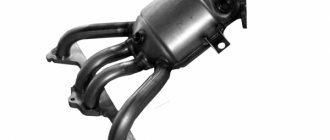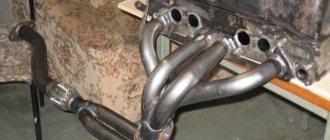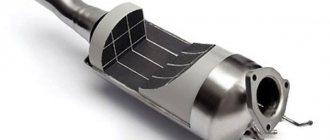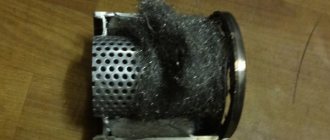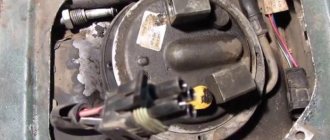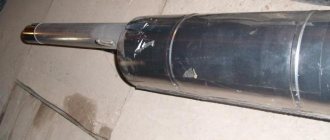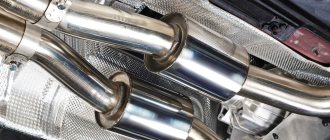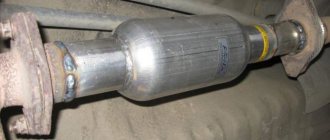The catalyst is a unit that serves to destroy nitrogen compounds that negatively affect the atmosphere and the environment. The device turns them into harmless substances - nitrogen, water and carbon monoxide.
Depending on the year of production of the VAZ 2114, they are equipped with catalysts that meet the requirements of Euro 2 or Euro 3 (2003-2008 and 2008-2013 model years, respectively).
Breakdowns and their signs
Typically, this element begins to “strange” when it travels about 150 thousand kilometers. That is, this is more likely an age-related problem with the car.
Standard and Modified
The catalyst consists of honeycombs that break down over time and do not block the release of harmful exhaust gases. The pressure in the exhaust system increases, exhaust gases go back into the engine, which leads to a significant deterioration in its performance. The engine is literally choking.
Typical signs that the catalyst is clogged are:
- The car's dynamics deteriorate significantly and noticeably;
- The engine starts with problems;
- There is a characteristic smell of sulfur in the cabin;
- The engine is unstable at idle.
If the car stops driving normally, it is advisable to immediately check the condition of this device. Alas, this cannot always be done in a garage environment, since special equipment and devices are required. But there are still two ways.
- Replace the lambda probe with a pressure gauge. Start the engine and check the pressure. If it is more than 0.5 atmospheres, things are bad.
- In the second case, you will need a remote pyrometer. If the catalyst is working normally, the temperature of the pipe before it will be higher than after it. But at the same temperature, this indicates the destruction of the honeycomb and a violation of the flame extinguishing function.
The second method allows you to obtain indirect data, so the pressure must be checked in any case. If a breakdown is detected, the catalyst must be replaced.
Replacing the device has its own characteristics depending on which engine is installed on your VAZ 2114 - eight-valve or sixteen-valve.
Installation procedure
- We install the flywheel in the reverse order in accordance with the mark made during disassembly. Before tightening the flywheel mounting bolts, apply thread locker to their threaded part.
The flywheel must be installed on the crankshaft in only one position. If the mark made has been erased, the flywheel can be installed on the shaft according to the factory mark - for this purpose, a hole is drilled on the outside of the flywheel. When installing the flywheel on the crankshaft, the mark should be located opposite the crankpin of the fourth cylinder. Do not confuse the mark with the balancing holes, which are made with a larger diameter drill
Replacement for an 8-valve engine
If you have a VAZ 2114 with an 8-valve engine, you need to look for this element in front of the middle resonator and after the exhaust manifold directly under the bottom of the car. Many, alas, ignore the need to replace it, believing that their car will not stop polluting the atmosphere and the engine will be able to continue to operate normally. The opinion is wrong, as you understand.
Device option for eight-valve
Some believe that instead of a failed filter device, you can install a regular corrugated pipe . Also a wrong decision. This will make the noise incredibly loud, and the exhaust gases will very quickly destroy the muffler. You can get by with a budget replacement option - cut out a section of the catalyst, knock out a honeycomb of ceramics from it and perform welding, thereby sealing the body. But be prepared for noise to become your constant companion.
It is best to replace the factory catalyst with an effective flame arrester. They assemble it with their own hands or seek help at a service station, and also purchase ready-made solutions at auto parts stores. Whichever option suits you best, choose that one.
Removing the unit and replacing it with another device is a matter of one hour. At the same time, there is no need to worry about electronics. There is only one oxygen sensor, and it is installed before the catalyst. Therefore, replacing it with a flame arrester will not affect the measurement readings in any way.
Why do we need Spider?
“Spider” is the same manifold, but with separate removal of exhaust gases from the engine cylinders at the initial stage. The essence of the “Spider” is better purging and cleaning of the cylinders from exhaust gases due to pressure fluctuations in the exhaust system. To achieve the desired effect in the manufacture of the “Spider”, pipes of a certain length are used. Moreover, the pipes connected to the block head are installed in the order of engine operation.
There are two types of Spider currently sold on the market: 4-1 and 4-2-1. The difference between them comes down to the fact that in the first type, 4 pipes that are connected to the block head converge into one pipe, and it is already connected before the catalyst. The “spider” of the second type is different in that its 4 pipes first turn into 2 pipes, and those, in turn, into one, which is connected to the catalyst. In addition, the internal cavity of the “Spider” does not have the filling that is found in the standard manifold. This filling ensures compliance with the Euro-3 standard, and it also “presses” the VAZ 2114 engine.
The “Spider” type also influences the achievement of the desired effect. In order for pressure fluctuations in the exhaust system with type 4-1 to ensure good purging of the cylinders, the engine speed must be above 6500 rpm. That is, it is advisable to install such a “Spider” only on forced engines that provide high speeds.
Type 4-2-1 allows you to achieve the desired effect at low speeds, which makes it possible to use them on the VAZ-2114 even without modifications to the power plant.
It should be installed instead of a standard manifold, it will not particularly affect the operation of the engine; it will also require removing the catalyst and installing a resonator and a direct-flow exhaust system. In general, the entire exhaust system will have to be replaced. After such alterations, the VAZ-2114 will not meet any standards, but the car will become more playful. In addition, in the future there will be no need to replace a clogged catalyst, since it simply will not be in the system.
As for the disadvantages, the Spider provides a louder sound because the exhaust gases move through a direct-flow system. Many people like this sound, but when traveling long distances it can be very annoying. And the second drawback is that there can be no talk of any environmental friendliness.
But if you are tired of driving a VAZ-2114 with an engine that “drives” very calmly, then you should still install the “Spider”.
Replacement on a 16-valve engine
In the case of a 16-valve power unit, the catalyst is included in the design with the output manifold. Therefore, look for it behind the cylinder block directly in the engine compartment.
To replace the unit, you will need a zero resistance catalytic converter. This insert is popularly called a spider. It is quite possible to complete the work in normal garage conditions. Just keep in mind that to gain access to this element you will have to dismantle the fuel rail.
The nuance of dismantling the 16-valve engine is the presence of two lambdas.
- The first is located directly on the catalyst. It serves to adjust the fuel mixture;
- The second is located on the flange after the device. It is called ecological. If this lambda is not in place, the sensor will immediately generate an error, the injection will stop working properly, thrust will increase and fuel consumption will increase.
There are two ways to solve this issue:
- If you bought a spider for one regulator, the electronic control unit can be upgraded to Euro 2 from the current Euro 3. But such a spider has a serious drawback - the only thread for the lambda is on the flange. To mount the injection lambda there, you will have to assemble an extension cord from a wire and two connectors, called mother-father.
- If it is a spider with two regulators, the injection lambda is mounted in a standard socket. The thread for the second sensor is plugged or a dummy for the electronic control unit is installed in its place. In the second situation, there is no need to reflash the ECU.
Replacing the flywheel crown of a VAZ 2109 with your own hands
- I decided to cheat a little and remove the transmission in a more convenient and simpler way - without draining the oil or disconnecting the drives. To do this, you need to completely remove both trailing arms, which are more often called “sabers”.
- Next, remove the starter and disconnect the rocker, both gearbox supports and the reverse sensor ground wires.
- When the levers are removed, the transverse travel of the struts is sufficient to disconnect the box from the engine.
- Place the removed gearbox on the floor, you should now have full access to the flywheel and clutch.
- To unscrew the flywheel bolts, you need to secure the flywheel itself well. There is a special clamp for this; if you don’t have one, you can make something similar. I made a homemade analogue for myself from a guide, which was taken from a server rack, with holes made in it. Afterwards, the guide was screwed to the flywheel using the basket mounting bolts. Use this improvised device to hold the flywheel from turning.
Popular myths
Varieties
Some people deliberately get rid of the catalyst, others deliberately ignore the clogged unit. All this caused the spread of myths.
- By removing it, the engine gains power. A misconception that arose for unknown reasons.
- The engine cannot “breathe” normally due to the catalyst. Absurd. It functions quite well if the cat itself is in working order.
- A clogged element ensures a more environmentally friendly ride. Another myth, the origin of which can only be guessed at. Rather, on the contrary, a clogged device harms nature and your car even more.
Therefore, monitor the condition of the catalyst on the VAZ 2114, check its functional condition, and if necessary, replace it with a new one or replace it with a flame arrester. Both options have shown their effectiveness.
Varieties
There are many types of catalysts for sale for a VAZ 2114 car. They are classified into types according to different criteria.
According to the degree of cleaning, the following auto parts are distinguished:
Depending on the material of the honeycomb structure, you can purchase the following part:
Depending on the condition you can buy a spare part:
Depending on the manufacturer, you can purchase the following brands of catalyst:
- VAZ (Russia)
- Polmostrow (Poland)
- Atiho (European Union)
- ASSO (Italy)
- Bosal (European Union)
- FortLuft (international company).
You can buy a catalyst for the VAZ 2114 at the following sales points:
- Car market.
- Special shop.
- Private advertisements in newspapers and online bulletin boards.
- Online store.
- Car dismantling point.
Malfunctions and their symptoms
Catalyst problems usually appear with age: by 150–200 thousand kilometers, the honeycombs that make up its filling are almost completely destroyed and prevent the exhaust gases from escaping. As a result, the pressure in the exhaust system increases, the exhaust gases are squeezed back into the engine, which literally “chokes” it. Signs of a clogged catalyst may include:
- severe deterioration in vehicle dynamics;
- uneven engine operation at idle speed;
- starting deterioration;
- smell of sulfur in the cabin.
If the car “does not drive”, before changing the sensors, it is worth checking the condition of the cata at a service station. It is problematic to do this in a garage environment: not everyone in the household has the necessary devices. There are two main methods of checking: manometric and pyrometric.
Catalyst device
In the first case, a pressure gauge is screwed in place of the lambda probe. When the engine is running, the pressure should not exceed 0.5 atmospheres. In the second case, a remote pyrometer is used. With a normal catalyst, the pipe temperature after it should be lower than before. If it is the same, the honeycomb is destroyed and the unit does not perform a flame-extinguishing function. This method is indirect, so it is better to rely on the results of a pressure test. If the diagnostics show a malfunction, the unit needs to be replaced.
Replacing the catalyst on an 8-valve VAZ 2114
On cars with an 8-valve engine, the catalyst is located under the bottom after the exhaust manifold and in front of the middle resonator. It is not customary in Russia to replace the catalyst with a new one and take care of the atmosphere: it is expensive and “strangles the engine.”
But you can’t just take and remove the catalyst and weld a pipe in its place (put in a corrugation). The noise of the car will become unbearable, and the hot exhaust gases will quickly burn out the muffler. The most budget-friendly method: cut the catalyst, knock out the ceramic honeycombs with a pry bar and weld the body back together. But this method is also the noisiest.
The optimal solution is to install a flame arrester instead of the catalyst. You can assemble it yourself or at a service station in an old building, or purchase it ready-made in a store. Removing the catalyst on an 8-valve VAZ 2114 usually does not require “witchcraft” with computer settings. There is only one oxygen sensor, and it is located before the catalyst, so changes do not affect its readings.
Replacing the catalyst on a 16-valve VAZ 2114
On a VAZ 2114 with a 16-valve engine, the catalyst is structurally combined with the output manifold and is located in the engine compartment immediately behind the cylinder block. To replace it, a special insert is used, a zero-resistance catalyst, better known as a “spider”. Removing the catalyst and installing a spacer can also be done in a garage. To gain access, you will need to remove the fuel rail.
The peculiarity of removing the catalyst on 16-valve VAZ 2114 cars is that there are two lambdas. The first is installed on the catalyst itself and is responsible for setting the fuel mixture, and the second, “ecological”, is located on the flange after the catalyst. Its absence will inevitably cause a sensor error, a check engine indication, incorrect injection operation, increased fuel consumption and poor traction. There are two ways out of this situation.
- If you purchased a spider for one sensor, the ECU needs to be flashed from Euro-3 to Euro-2. In addition, the spider for one sensor has a drawback: the only thread for the lambda probe is located on the flange. To screw in the “injection” lambda, you need to assemble an extension cord from two male-female connectors and a wire.
- If there is a spider for two sensors, the “injection” lambda can be installed in its original place. The thread for the second sensor can be plugged or a “dummy” for the computer can be installed there. In the second case, flashing the ECU to Euro 2 will not be required.
Before removing the catalyst, you need to understand why it is needed. The power gain from this procedure is a myth. As well as the belief that an engine with a catalyst “does not breathe.” Removing a working cat (and if the odometer shows less than 100 thousand kilometers and diagnostics show the system is working, it works) will not add additional horses. However, the belief that driving with a clogged catalyst is more environmentally friendly than driving without it is also a fallacy.
Some features
There are several nuances that should be taken into account when modifying the exhaust system of a VAZ-2114. The installed tuning manifold is wider in size, so it will touch the rubber pipe leading to the stove. To prevent this from leading to coolant leakage in the future, this pipe should be replaced with a new, longer one, and taken away from the manifold. The lambda probe will also have to be replaced, since the hole for its mounting in the tuning manifold is lower than in the standard one, which is why this sensor with extended wiring is needed.
Also, the “Spider” is more voluminous at the bottom, so installing underbody protection is no longer possible.
The final stage of all this work is reflashing the electronic control unit, which will allow the new exhaust system to be “perceived” as standard. Also, flashing will allow you to “unleash” the full potential of the power plant after processing. It is better to perform flashing from knowledgeable specialists at a service station.
This is all the work related to the processing of the exhaust system of the VAZ-2114 car.
Where is the catalyst for the VAZ 2114
During the 70s and 80s, the domestic automobile industry was just beginning to develop. Having a car at that time was a luxury. Even if you had money, you could not afford a vehicle because it was in short supply. In this regard, there were not a lot of cars on the city streets, to put it mildly. You can't say that these days. Nowadays, literally anyone can buy a car. Stepping out onto the street, cars rush past us without stopping, and numerous traffic jams accumulate at intersections.
Considering that every car, during its operation, emits a certain amount of exhaust gases that pollute the environment, this issue soon became a problem. Therefore, to reduce the emission of harmful substances, designers came up with a very effective thing - a catalyst.
This mechanism is installed mainly on more modern cars. For example, take the VAZ 2114. Its design provides for the presence of a catalyst. Let's take a closer look at what it is responsible for and how it works.
TYPES
This cleaning device is divided into types, depending on the material on which the cleaning layer is located. It can be ceramic or metal. Shape: cube, honeycomb, or longitudinal block.
The most common type on VAZ 2114 cars is ceramic. This is due to its affordable price. But it has one negative quality - the fragility of the structure. That is, if you fall into a deep hole, your catalyst may crumble into pieces. Also, if during a long trip, when the exhaust system overheats, water gets on the cleaning device, the ceramic coating will crack and lose its tightness, and with it the benefits of its work.
With a metal catalyst, this of course will not happen, but this type of unit is not installed on the VAZ 2114.
Approximate prices
In Russia, you can buy an original catalytic converter for a VAZ 2114 at a price from 200 to 5500 rubles. A non-original new part costs from 4,000 to 12,000 rubles. Used spare parts are sold for 100-4000 rubles (depending on condition). Approximate prices from different manufacturers are shown in the table below.
| Manufacturer | Cost of a new part, rub. | Price of used spare parts, rub. |
| Polmostrow | 4450-6000 | 100-3000 |
| Atiho | 6500-7500 | 150-2500 |
| ASSO | 4000-5000 | 200-2000 |
| Bosal | 8000-10000 | 150-3500 |
| FortLuft | 7000-12000 | 200-4000 |
DEVICE
On Lada 2114, the catalyst was installed in the muffler. It consisted, as a rule, of a ceramic shell, in the form of a honeycomb, and a filler, in the form of rhodium, palladium and platinum. On a Euro 3 engine, instead of a ceramic shell, you can find a metal one.
Internal organization
Since the design of such a cleaning mechanism completely blocks the free passage of exhaust gases, if there is a malfunction or clogging, the cleaning insert becomes too dense and does not allow gases to pass through. This factor fully affects the operation of the engine.
SYMPTOMS OF MALFUNCTION
Over time, this mechanism becomes unusable and requires repair or replacement. Typically, a VAZ 2114 catalyst can operate for about 150 - 200 thousand kilometers. After this, the filler becomes so clogged that exhaust gases cannot penetrate through them. You can determine that this mechanism is faulty by a number of characteristic symptoms.
The first thing that becomes noticeable, even when the catalyst is working, but already in its critical condition, is a sharp deterioration in dynamics. For example, acceleration to 100 km/h, instead of 13 seconds, will take 17 - 20, and the free wheeling will practically disappear.
The second sign is unstable idle speed. Due to the fact that the purifier will be practically clogged, some of the exhaust gases will return to the combustion chamber. Since the engine does not generate pressure at idle speed, the reverse flow of gases will simply “choke” it.
The third sign is deterioration in engine starting. Since exhaust gases will not exit through the exhaust pipe, they will remain in the system even when the car is not running. Therefore, when you try to start the engine, the gases will mix with fuel fumes, and a fire will not occur.
And the last, fourth sign is a distinct smell of sulfur in the car interior. Since the exhaust gas removal mechanism passes through the entire car, if it is clogged, gases will penetrate into the ventilation cracks, polluting the interior of the car.
Ways to solve the problem with interior heating
Having looked at tuning the cooling system of the VAZ 2114 to solve the problem of overheating in the summer, let's look at how you can increase the efficiency of heating the interior. The solution to the problem under consideration is to redirect water from the heater to the thermostat to maintain the most optimal temperature regime. Of course, such a modification is much more complicated than all those previously considered, since there is no suitable pipe for draining water. That is why the work in question involves the creation of a new pipe.
It is quite important to choose the right location when making such a change. The accuracy of temperature control of the internal combustion engine, and therefore the efficiency of the system, will depend on this. The principle of the changes is as follows:
- A new pipe is soldered.
- The new pipe is placed opposite the standard one.
- The pump hole should be plugged to redirect the fluid.
Such a scheme for changing the car’s cooling system should not cause much difficulty. It is important to pay attention to the sealing of all elements, since when heated, the liquid in the system circulates under pressure. If the new pipe does not hold securely in place, then there is a possibility of a leak, which will cause the antifreeze to leak out and cause the engine to overheat.
REPAIR OR REPLACEMENT
Replacing a catalyst on a VAZ 2114 costs the same as repairs. Therefore, it is quite difficult to decide whether to change or repair this device. The most common solution is replacement, since repairs take much longer. Replacement can be done both at a car service center and at home. The problem with replacement is that simply cutting out the catalyst and welding a piece of pipe will not work, because, in addition to cleaning the exhaust gases, this mechanism also muffles the exhaust sound. And without it, the sound will be simply catastrophic.
This problem can be solved by installing a flame arrester. This device is sold in almost every car store. It costs much less than a new catalyst. You just need to buy it, and you can install this device at a service station, and it won’t cost much, and the result will be obvious.
Characteristic
The catalytic converter on the VAZ 2114 is a device that filters exhaust gases and prevents harmful substances from entering the atmosphere. It is an integral part of any car. It has a fairly simple structure. Cleaning occurs due to honeycombs with catalytic spraying.
The catalyst may break down or become clogged over time. The condition of this spare part needs to be checked every 50,000 km. It is important to carry out timely replacement. Otherwise, the motorist may face a number of problems: from increased fuel consumption to the inability to start the car.
Source
Pipe instead of catalyst VAZ 2114
Catalyst
As you know, most modern cars have a catalytic converter. New VAZ models are no exception.
It is designed for cleaning waste and is sometimes installed in the exhaust system of a car. A lot depends on this seemingly insignificant detail. Thus, the catalyst, as the part is called differently, improves dynamic characteristics and also reduces fuel consumption. Replacing the catalyst on a VAZ 2114 is sometimes necessary if a flame arrester is installed instead.
However, a catalyst replacement is not installed on the VAZ 2114 as often as it is replaced due to breakdown or malfunction. It's easy to make a replacement.
You just need to arm yourself with patience and the necessary tools, and follow the instructions below.
The following tools will be needed:
- new catalytic converter or flame arrester;
- inspection hole;
- wrenches;
- heat-resistant pipe;
- electronic emulator.
Pricing factors
Catalysts for the VAZ 2114 are sold at different prices. When forming the price level, sellers take into account the following:
- New or used part is for sale.
- A place where spare parts are sold.
- What is the level of competition in the region, what is the average market price for the part.
- Is the spare part original?
- Manufacturer's fame.
- What type of spare part is being sold?
- Do I need delivery or installation of a catalyst? These services are paid separately.
HOW TO DETERMINE THAT THE CATALYST HAS BEEN UNUSED
Bad catalyst
Typically this can be seen, heard or even felt through the sense of smell:
- So, if the ceramics crack, it begins to rattle in the metal case.
- In addition, exhaust gases acquire an unpleasant odor while driving if the catalyst is faulty.
- As for the color of gases, they also change dramatically. Instead of the usual color, gases with a faulty catalyst become like black soot.
- Engine power is also reduced, especially on inclines.
DISASSEMBLY OF THE CATALYST
To properly remove the catalyst from the car, you need to jack it up or put the car on a viewing hole. The process of removing the catalytic converter will not take more than thirty minutes and no special tools are needed for the work. The catalyst housing is located on the Samara behind the engine exhaust manifold. So:
- we find the mounts for the resonator, which is located behind the exhaust manifold or pants, as experts call it;
- unscrew the fastenings;
- remove the spring type washers;
Removing the catalyst
- unscrew the fastenings of the exhaust pipe (in this case, you need to remove the bolts along with the springs, holding the catalyst with the other hand from below):
- remove the catalyst.
Now the owner himself decides what to do. He can put a new catalyst on the car, or he can make a homemade flame arrester and install it.
Making a flame arrester
Homemade flame arrester VAZ
A flame arrester and a catalyst have a lot in common. But the flame arrester, compared to the catalyst, does not delay the flow of hot exhaust, thereby increasing the jerk and power of the engine.
In addition, it has a direct-flow design, and it will cost less to install than a new catalytic converter. It is not possible to buy a ready-made flame arrester.
Therefore, you will have to do it yourself. On a VAZ 2114, replacing the catalyst with a flame arrester will require a little skill and knowledge of certain secrets.
Let's start with the pipes. We take two metal tubes of different sizes. The diameter of the first pipe should be the same as that of the exhaust system.
The second one has much more.
Replacing the VAZ 2114 catalyst begins with the following:
- drill 3-6 mm holes in the first pipe around the circumference and the entire length;
- we insert the pipe in the center into the second one, which has a much larger diameter;
- connect the welding machine;
- We weld one edge of the pipe connection;
- leave the other edge and cut it lightly with a grinder (this is done to leave room for bending);
- take metal sponges and stretch them;
Metal wool on the flame arrester
- they should be inserted alternately onto the edge of the pipe;
- taking a metal rod, push the washcloths as deep as possible (basically, it takes about 30 washcloths used by housewives in the kitchen);
- we bend the cut edge of the large pipe (this must be done so as not to remove the metal wool from the pipe);
- bends should be welded (scouring pads and tight welding will help to avoid the noise that the flame arrester will make while the car is operating);
- take good anti-corrosion paint (high-quality paint is sold in cans);
- we treat the flame arrester with it;
- cut out the old catalyst;
- insert the flame arrester there.
It is worth noting that even a homemade flame arrester meets all Euro 2 standards.
In this article you can see how to replace the VAZ 2114 video catalyst and understand the main nuances of the work.
What is a lambda probe
Catalyst circuit and oxygen sensor
The replacement of the VAZ 2114 catalyst, as mentioned above, meets all the parameters. But if, nevertheless, the standard should be higher than Euro 2, you can use a lambda probe.
This is a special sensor that, after removal, transmits an error to the control unit. But this is not a solution either, since this installation will affect engine performance or fuel consumption.
- A sensor is a special device that measures the oxygen content in exhaust gases.
- It then transmits this information to the electronic power system.
- The power system, in turn, begins to control the composition of the combustible mixture, that is, fuel, and maintains the optimal ratio of air and gasoline.
- If the sensor is faulty, it gives a signal to the control to maximize the enrichment of the working mixture.
The same thing happens not only when the sensor is faulty, but also when it is turned off. Measuring CO at the moment, the device shows up to 9%. Well, the deterioration in engine performance and an increase in fuel consumption by as much as 50% is unlikely to go unnoticed by the driver. It turns out that on cars such as the VAZ 2114, where a catalyst is installed or to replace the catalyst with a VAZ 2114, a special device operates in the exhaust system , which measures CO.
Attention : you can also check the operation of the catalyst using the sensor. First of all, you need to find it. It is located in the exhaust pipe, where the manufacturers successfully screwed it in.
Sequence of work
With all this at hand, you can get to work:
- We install the VAZ-2114 on the inspection hole and immobilize it. If the car is just from a trip, give the exhaust system time to cool. Remove the crankcase protection.
- We unscrew the bolts securing the exhaust manifold pants from the exhaust pipe of the catalyst and disconnect them. It is better to pre-treat the fastening bolts with WD-40.
- If the replacement is only partial, leave the catalyst and muffler in place for now. But with a complete replacement, we remove everything that comes from the collector’s pants from the VAZ-2114.
- Let's move on to the engine compartment. We unscrew the nuts securing the exhaust manifold to the block head, having previously treated them with WD-40.
- Carefully remove the standard manifold and the gasket located under it.
- Next, the Spider is installed. If the choice is made correctly, it will fall into place without problems. It is important not to forget to install a new gasket under it. If the old fastening nuts are heavily rusted, it is better to replace them with new ones, copper-plated or brass.
- Let's go under the car. In case of partial replacement, we try on the coincidence of the “Spider” with the exhaust pipe of the catalyst. Usually the “spider” is longer than the standard manifold, so the exhaust system will have to be shortened, which is why a grind is needed. machine (grinder) and welding machine. Then the catalyst is completely cut out. Along with the catalyst, it may be necessary to remove part of the pipe that goes behind it. And in its place a resonator is welded in, everything is first adjusted to the length.
- We connect the “Spider” to the receiving pipe of the resonator. This completes the partial replacement.
- For a complete replacement, we do the same as for a partial replacement, but with a new direct-flow system and resonator. That is, we hang a new exhaust system with a resonator on the car, take measurements, adjust it to length if necessary, connect and secure everything.
OTHER CATALYST REPLACEMENT OPTIONS
Often the car owner does not want to install either a new catalyst or a flame arrester. This also happens.
In this case, he can be advised of two options: install an insert on the old muffler or replace the catalyst with a VAZ 2114 by gutting the body and welding it, first stuffing shavings inside.
Installing a special insert
special insert for catalyst
The photo above shows what the model should be like. We arm ourselves with special tools and begin:
- with our own hands we make a model with flanges from a metal pipe (the cross-section of the pipe should be the same as that of the exhaust system of the car);
- We don’t touch the old system;
- We insert the pipe with flanges into the catalyst.
